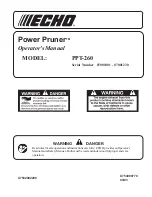
-32-
Model G0622 (Mfg 2/08+)
SyMpTOM
pOSSIBLE CAUSE
CORRECTIvE ACTION
Machine is loud when
cutting or bogs down in
the cut.
1. excessive feed rate.
2. the blade tpi is too great, or the
material is too coarse.
1. refer to
feed Rate on page 24, or Blade Speed
on
page 25 and adjust as required.
2. refer to
Blade Selection on page 26 and adjust as
required.
Blades break often.
1. the workpiece is loose in the vise.
2. the feed or cut speed is wrong.
3. the blade tpi is too great, or the
material is too coarse.
4. the blade is rubbing on the wheel
flange.
5. the bandsaw is being started with
the blade resting on the workpiece.
6. the guide bearings are
misaligned, or the blade is rubbing
on the wheel flange.
7. the blade is too thick, or the
blades are of low quality.
1. Clamp the workpiece tighter, or use a jig to hold the
workpiece.
2. refer to
feed Rate on page 24, or Blade Speed
on
page 25 and adjust as required.
3. refer to
Blade Selection on page 26 and adjust as
required.
4. refer to
Blade Tracking on page 34, and adjust as
required.
5. Start bandsaw and then slowly lower the headstock
by setting the feed rate.
6. refer to
Blade Tracking on page 34, or Blade
Guides on page 24, and adjust as required.
7. Use a higher quality blade.
Blade dulls prematurely.
1. the cutting speed is too fast.
2. the blade tpi is too coarse.
3. the blade feed pressure is too
light.
4. the workpiece has hard spots,
welds, or scale is on the material.
5. the blade is twisted.
6. the blade is slipping on the
wheels.
1. refer to
Blade Speed on page 25 and adjust as
required.
2. refer to
Blade Selection on page 26 and adjust as
required.
3. refer to
feed Rate on page 24, and adjust as
required.
4. increase the feed pressure, and reduce the cutting
speed.
5. replace the blade.
6. refer to
Blade Tension on page 35, and adjust as
required.
Blade wears on one side.
1. the blade guides are worn or mis-
adjusted.
2. the blade guide slide bracket is
loose.
3. the wheels are out of alignment.
1. refer to
Blade Guides on page 24 and replace or
adjust.
2. tighten the blade guide bracket.
3. refer to
Blade Tracking on page 34, and adjust as
required.
teeth are ripping from the
blade.
1. the feed pressure is too heavy
and the blade speed is too slow; or
the blade tpi is too coarse for the
workpiece.
2. the workpiece is vibrating in the
vise.
3. the blade gullets are loading up
with chips.
1. refer to
Blade Selection on page 26 and decrease
the feed pressure. refer to
feed Rate on page 24,
and adjust as required.
2. re-clamp the workpiece in the vise, and use a jig if
required.
3. Use a coarser-tooth blade.
the cuts are crooked.
1. the feed pressure is too high.
2. the guide bearings are out of
adjustment, or too far away from
the workpiece.
3. the blade tension is low.
4. the blade is dull.
5. the blade speed is wrong.
1. refer to
feed Rate on page 24, and adjust as
required.
2. refer to
Blade Guides on page 24 and replace or
adjust.
3. refer to
Blade Tension on page 35, and adjust as
required.
4. refer to
Blade Change on page 33 and replace
the blade.
5. refer to
Blade Speed on page 25 and adjust as
required.
Summary of Contents for G0622
Page 44: ... 42 Model G0622 Mfg 2 08 ...
Page 48: ......















































